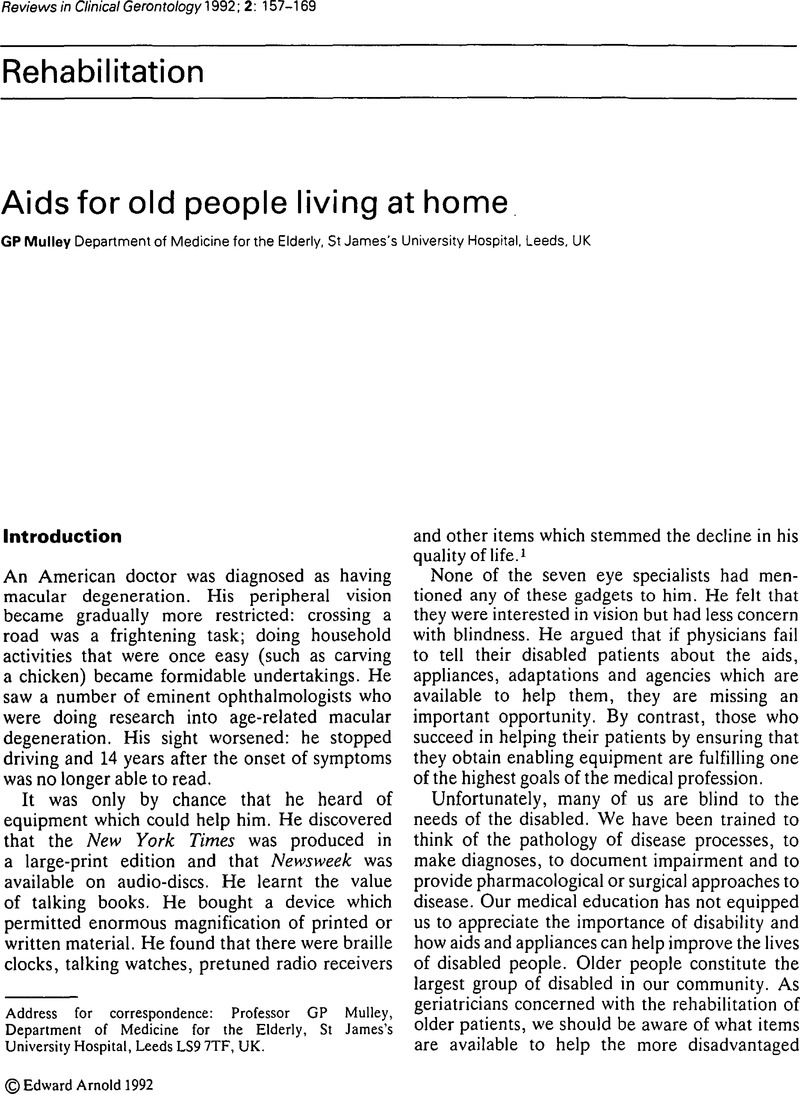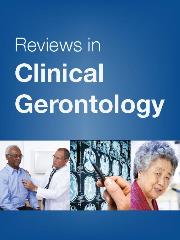No CrossRef data available.
Article contents
Aids for old people living at home
Published online by Cambridge University Press: 17 November 2008
Abstract
An abstract is not available for this content so a preview has been provided. Please use the Get access link above for information on how to access this content.

- Type
- Rehabilitation
- Information
- Copyright
- Copyright © Cambridge University Press 1992
References
3 King Edward's Hospital Fund for London. Report on services for the elderly in the Metropolitan Borough of Lewisham. London: 1964.Google Scholar
4Clark, M, Clark, S, Odell, A, Jagger, C.The elderly at home: health and social status. Health Trends 1984; 16: 3–7.Google Scholar
5Salvage, AV, Jones, DA, Vetter, NJ.Awareness of and satisfaction with community services in a random sample of over 75s. Health Trends 1988; 20: 88–92.Google Scholar
6Hart, D, Bowling, A, Ellis, M, Silman, A.Locomotor disability in very elderly people: value of a programme for screening and provision of aids for daily living. Br Med J 1990; 301: 216–20.CrossRefGoogle ScholarPubMed
7Blaxter, M.The meaning of disability: a sociological study of impairment. London: Heinemann, 1976.Google Scholar
11Mackean, JM, Elkington, AR.Compliance with treatment of patients with chronic open-angle glaucoma. Br J Ophthalmol 1983; 67: 46–49.CrossRefGoogle ScholarPubMed
12Silver, JH, Gould, ES, Irvine, D, Cullinan, TR.Visual acuity at home and in eye clinics. Trans Am Ophthalmol Soc UK 1978; 98: 262–66.Google ScholarPubMed
13Young, JB, George, J.When assessing elderly people, don't forget their spectacles. Ceriatr Med 1987; 17: 12–13.Google Scholar
14Hillman, JS.Aids for low vision in the elderly. Br Med J 1988; 296: 102–103.CrossRefGoogle ScholarPubMed
15Cullinan, TR.Epidemiology of visual disability. Trans Am Ophthalmol Soc UK 1978; 98: 267–69.Google ScholarPubMed
17Herbst, KG, Humphrey, C.Hearing impairment and mental state in the elderly living at home. Br Med J 1980; 281: 903–905.CrossRefGoogle Scholar
18Herbst, KG, Humphrey, C.Prevalence of hearing impairment in the elderly living at home. J R Coll Gen Pract 1981; 31: 155–60.Google ScholarPubMed
19Watson, C, Crowther, AJ.Provision of hearing aids: does specialist assessment cause delay? Br Med J 1989; 299: 437–39.CrossRefGoogle ScholarPubMed
20Anonymous editorial. Hearing problems in elderly people: implications for services. Lancet 1987; i: 1181–82.Google Scholar
21Littlejohns, P, John, AC.Auditory rehabilitation: should we listen to the patient? Br Med J 1987; 294: 1063–64.CrossRefGoogle ScholarPubMed
22Townsend, P, Wedderburn, D. The aged in the welfare state. Occasional papers in social administration No. 14. london: G Bell and Sons, 1965.Google Scholar
24Williams, EL.A model to describe performance levels in elderly people. J R Coll Gen Prac 1986; 36: 422–23.Google Scholar
27Chamberlain, MA, Buchanan, J, Hanks, H.The arthritic in an urban environment. Ann Rheum Dis 1978; 38: 51–56.CrossRefGoogle Scholar
28Chamberlain, A.Aids and equipment for the arthritic. Practitioner 1980; 224: 65–71.Google ScholarPubMed
29Brooks, BM.An investigation of factors affecting the use of buses by both elderly and ambulant disabled persons. Transport and Road Research Laboratory Contract Report. British Leyland UK Ltd, 1974.Google Scholar
32White, EG, Mulley, GP.Footwear worn by the over 80s: a community survey. Clinical Rehabilitation 1989; 3: 23–25.CrossRefGoogle Scholar
33Wolff, HS.Tools for living-personal view of new status for disabled in society. J Biomed Eng 1981; 3: 329–30.CrossRefGoogle Scholar
35Towle, D, Lincoln, NB, Mayfield, LM.Service provision and functional independence in depressed stroke patients and the effect of social work intervention on these. J Neural Neurosurg Psychiatry 1989; 52: 519–22.CrossRefGoogle Scholar
37Ellis, M.Choosing easy chairs for the disabled. Br Med J 1988; 296: 701–702.CrossRefGoogle ScholarPubMed
40Nichols, PJR, Mowatt, AG. Splints, walking aids and appliances for the arthritic patient. Reports on Rheumatic Diseases No. 48. London: The Arthritis and Rheumatism Council, 1972.Google Scholar
42Sainsbury, R, Mulley, GP.Walking sticks used by the elderly. Br Med J 1982; 284: 1751.CrossRefGoogle ScholarPubMed
44Bennett, L, Murphy, CE.Slipping cane and crutch tips Part 1. Static performance of current devices. Bull Prosthet Res 1977; 10: 71–90.Google Scholar
46Dobrin, L.Origin and evolution of the walkerette. Mt Sinai J Med 1980; 47: 172–74.Google ScholarPubMed
47Goodwill, J. Wheelchairs. In: Goodwill, CJ, Chamberlain, MA eds. Rehabilitation of the physically disabled adult. London: Croom Helm, 1988: 701–23.Google Scholar
48Crewe, R.Patient transportation in Wessex. Care, Science and Practice 1982; 1: 18–21.Google Scholar
49Haworth, E, Powell, RH, Mulley, GP.Wheelchairs used by old people. Br Med J 1983; 287: 1109–1110.CrossRefGoogle ScholarPubMed
50Young, JB, Belfield, PW, Mascie-Taylor, BH, Mulley, GP.The neglected hospital wheelchair. Br Med J 1985; 291: 1388–89.CrossRefGoogle ScholarPubMed
51Penn, ND, Belfield, PW, Young, JB, Whitley, AJ, Mulley, GP, Mascie-Taylor, BH.No more flat tyres: a trial of tyre insert for wheelchairs. Clinical Rehabilitation 1989; 3: 149–50.CrossRefGoogle Scholar
53Platts, EA.Wheelchair design-survey of users's views. Proc R Soc Med 1974; 67: 414–16.Google Scholar
54Harris, A, Cox, E, Smith, CRW. Handicapped and impaired in Great Britain. Part 1. Office of Population Censuses and Surveys. Social Survey Divisions. London: HMSO, 1971.Google Scholar
55Calder, CJ, Kirby, RL.Fatal wheelchair-related accidents in the United States. Am J Phys Med Rehabil 1990; 69: 184–90.CrossRefGoogle ScholarPubMed
56Reuler, JB, Cooney, TG.The pressure sore: pathophysiology and principles of management. Ann Intern Med 1981; 94: 661–66.CrossRefGoogle ScholarPubMed
57Mahoney, FI, Barthel, DW.Functional evaluation: the Barthel index. Md Med J 1965; 14: 61–65.Google ScholarPubMed
58Spiegel, JS, Hirshfield, MS, Spiegel, TM.Evaluating self-care activities: comparison of a self-reported questionnaire with an occupational therapy interview. Br J Rheumatol 1985; 24: 357–61.CrossRefGoogle Scholar
59Iliffe, S, Haines, A, Gallivan, S, Booroff, A, Goldenberg, E, Morgan, P.Assessment of elderly people in general practice. 2: functional abilities and medical problems. Br J Gen Pract 1991; 41: 13–15.Google ScholarPubMed
60Brodzka, WK, Thornhill, HL, Zarapkar, SE, Malloy, JA, Weiss, L.Long-term function of persons with atherosclerotic bilateral below-knee amputation living in the inner city. Arch Phys Med Rehabil 1990; 71: 895–900.Google ScholarPubMed
61Ebrahim, S, Nouri, F, Barer, D.Measuring disability after a stroke. J Epidemiol Community Health 1985; 39: 86–89.CrossRefGoogle ScholarPubMed
62Wade, DT, Hewer, RL.Functional abilities after stroke: measurement natural history and prognosis. Neural Neurosurg Psychiatry 1987; 50: 177–82.CrossRefGoogle ScholarPubMed
63Penn, ND, Belfield, PW, Mascie-Taylor, BH, Mulley, GP.Old and unwashed: bathing problems in the over 70s. Br Med J 1989; 298: 1158–59.CrossRefGoogle ScholarPubMed
64Anderson, R.The contribution of informal care to the management of stroke. Int Disabil Stud 1988; 10: 107–12.CrossRefGoogle Scholar
65Haworth, RJ, Hopkins, J.Use of aids following total hip replacement. Br J Occ Ther 1980; 43: 398–400.CrossRefGoogle Scholar
66George, J, Kerr, AAJ.Equipment for bathing. Br Med J 1988; 296: 982–83.CrossRefGoogle ScholarPubMed
67Chamberlain, MA, Thornley, G, Stowe, J, Wright, V.Evaluation of aids and equipment for the bath. II: a possible solution to the problem. Rheum Rehabil 1981; 20: 38–43.CrossRefGoogle Scholar
68Chamberlain, MA, Thornley, G, Wright, V.Evaluation of aids and equipment for bath and toilet. Rheum Rehabil 1978; 17: 187–94.CrossRefGoogle ScholarPubMed
69London Borough of Hillingdon Domiciliary Services evaluation. Part II: five types of aid in common use. London: Social Services Research, 1976.Google Scholar
71Ebrahim, S, Nouri, F.Caring for stroke patients at home. Int Rehabil Med 1987; 8: 171–73.Google ScholarPubMed
72Page, M, Galer, M, Fitzgerald, J, Feeney, RJ. Problems in the selection, provision and use of aids. In: Bray, J and Wright, S eds. The use of technology in the care of the elderly and the disabled-tools for living. London: Pinter, 1980: 119–23.Google Scholar
73Walker, MF. Dressing after stroke [Thesis]. Nottingham: University of Nottingham, 1991.Google Scholar
75Naylor, JR, Mulley, GP.Surgical collars: a survey of their prescription and use. Br J Rheumatol 1991; 30: 282–84.CrossRefGoogle Scholar
78Robertson, JC, Haines, JR.A community/hospital home aids loan scheme (based on a Rehabilitation Demonstration Centre). Health Trends 1978; 10: 15–16.Google Scholar
80Hanger, HC, Mulley, GP.A survey of lower leg braces worn by the over-60s. Clinical Rehabilitation 1991; 5: 95–101.CrossRefGoogle Scholar




